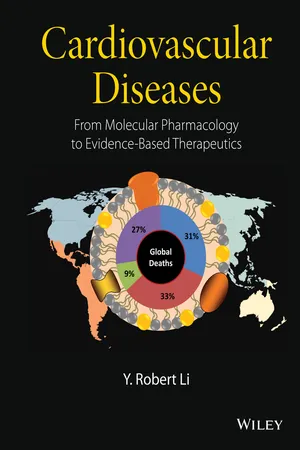
Cardiovascular Diseases
From Molecular Pharmacology to Evidence-Based Therapeutics
- English
- ePUB (mobile friendly)
- Available on iOS & Android
About This Book
Written in an accessible style and consistent format, the book covers both the fundamentals and advances in the pharmacology of cardiovascular drugs, as well as their integrated applications in the management of individual cardiovascular diseases. • Integrates fundamentals and recent advances regarding cardiovascular drugs, blending basic and clinical sciences needed to effectively understand and treat cardiovascular diseases
• Facilitates understanding of drug action and mechanism by covering physiology / pathophysiology and pharmacology
• Includes guidelines and algorithms for pharmacotherapeutic management of cardiovascular diseases
• Uses case presentations and study questions to enhance understanding of the material
• Serves as a resource for pharmaceutical and medical students and researchers interested in cardiovascular issues
Frequently asked questions
Information
Unit III
Hypertension and Multitasking Cardiovascular Drugs
6
Overview of Hypertension and Drug Therapy
6.1 Introduction
6.2 Definitions, Classifications, and Epidemiology of Hypertension
6.2.1 Definitions and Classifications
6.2.1.1 The JNC7 Classification of Blood Pressure
| Blood pressure classification | Systolic blood pressure (mm Hg) | Diastolic blood pressure (mm Hg) |
| Normal | <120 | and <80 |
| Prehypertension | 120–139 | or 80–89 |
| Stage 1 hypertension | 140–159 | or 90–99 |
| Stage 2 hypertension | ≥160 | or ≥100 |
6.2.1.2 Hypertension Crisis
6.2.1.3 Primary and Secondary Hypertension
- Kidney diseases, especially chronic kidney disease [1]
- Primary aldosteronism [2]
- Cushing’s syndrome [3]
- Pheochromocytoma [4]
| Cause | Major mechanism |
| Kidney diseases | Increased renin release due to decreased perfusion |
| Primary aldosteronism | Water and salt retention due to increased levels of aldosterone |
| Cushing’s syndrome | Water and salt retention due to increased release of corticosteroids |
| Pheochromocytoma | Release of catecholamines from the tumors of the adrenal chromaffin cells |
6.2.1.4 Systemic and Pulmonary Hypertension
6.2.2 Epidemiology and Health Impact of Hypertension
6.2.2.1 Epidemiology
Table of contents
- Cover
- Title page
- Table of Contents
- Preface
- List of Abbreviations
- Unit I: General Introduction
- Unit II: Dyslipidemias
- Unit III: Hypertension and Multitasking Cardiovascular Drugs
- Unit IV: Ischemic Heart Disease: Stable Ischemic Heart Disease
- Unit V: Ischemic Heart Disease: Acute Coronary Syndromes
- Unit VI: Heart Failure
- Unit VII: Cardiac Arrhythmias
- Unit VIII: Ischemic Stroke
- Index
- End User License Agreement